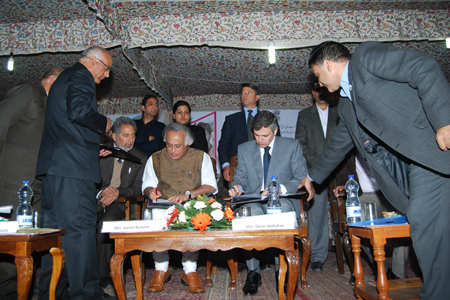With the retention rate of the trained school dropouts jumping from 40 to 75 percent, third batch of more than 1400 youth got job letters last week. As the planners are addressing issues as and when they crop up, India’s rural development ministry inked an agreement taking JKEDI as a management unit for the scheme, R S Gull reports.
In the rural development ministry, Rubeena, a girl from north Kashmir, is considered a role model. She is one of the few die-hards who refused to leave Chandigarh when most of her group deployed under Himayat fled for a varied set of reasons. “One day, she will be a politician,” India’s rural development minister, Jairam Ramseh, told boys and girls in Sopore. “The way she speaks, Shiv Raj Patil, our former home minister, who is now governor of Punjab, was so impressed that he said Kashmiri girls have started coming out of home.”
This is what the Rs 235 crore Skill, Empowerment and Employment (SEE) scheme repackaged as Himayat is aimed at: training boys and girls who drop out of schools for whatever reasons in different crafts that market demands and finally getting them private sector jobs, preferably in J&K and, if possible, outside the state. Initially, recalls Jairam, parents would tell us that if boys are to be sent outside for jobs, it is ok. But girls should get jobs within the state. “But it has changed as boys as well as girls are keen to serve outside J&K,” Jairam said. The minister, whom Omar has repeatedly termed ‘a friend of Kashmir’, insists Kashmiri girls are more confident and willing to work anywhere which is an encouraging trend. Given the limitations of private sector in the state, Jairam said, not all the 100 thousands youth to be trained and given jobs can get placements within J&K.
Unemployment is a major issue in J&K and Omar Abdullah, like his predecessors, is so keen to help Himayat become a success. Given the state’s income at Rs 6500 crore a year and the outgo on wages, salary and power deficit at Rs 16500 crore, creating jobs within the government is untenable and impossible, Omar made it clear last week at a huge function in the lawns of Entrepreneurship Development Institute (EDI) that, to his surprise, had a number of girls who are his fans, “Private sector is the only option,” he said in very clear terms.
The scheme suffered serious setbacks in the initial year. As recruits were deployed on jobs, especially outside the state, they deserted, either for low wages or for lack of basic facilities. As implementers continued addressing the problems, improvements are visible. The retention rate has already jumped from 40 percent in the first batch to 75 percent in the second batch. of the 2431 trained drop-outs, job letters have already been given to 1708. Last week, on the eve of Eid, 1423 letters were given to the third batch and half of them would serve within the state.
The first batch of 1030 got job letters in December 2011. Of them 722 reported to their jobs and 280 of them are still working at the positions they were given which means 40 percent retention. In the second batch, when 1136 job letters were given in July 2012, 986 reported to their jobs and 740 are still working making it retention of 75 percent.
“Though fundamentals of the scheme remained the same, it is still an evolving process,” Jairam said, “We are learning by experience.” In the last two years, the scheme aimed at handholding 100 thousand school dropouts to find jobs in the private sector within and outside J&K was reviewed twice. Every time a review took place, there was some decision that added to the systems to make the scheme more attractive and sustainable on long term basis.
Initially, for instance, the scheme was offering Rs 2000 a month for a maximum of two months to every trained youth as post-placement allowance to take care of basic needs near work place. Since the initial wages, especially outside J&K, were meager, the candidates were not getting any major help from this allowance. “After we found it inadequate, the allowance was extended to six months,” Jairam said.
Unlike the youth getting jobs within J&K, those deployed in Chandigarh, Delhi, UP or Himachal are facing certain basic problems. They were not getting rooms on rent because they were residents of Kashmir. Initial batches who got jobs in Chandigarh returned after deserting simply because they had no respectable shelter.















